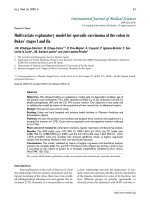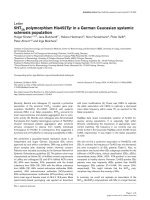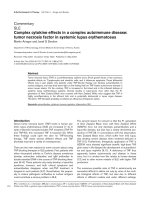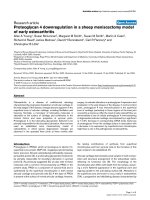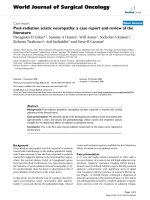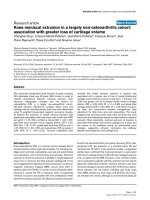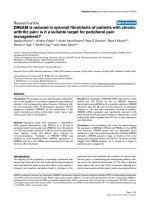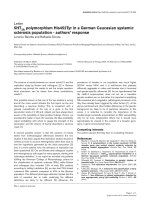Báo cáo y học: "Mirror-Image Arachnoid Cysts in a Pair of Monozygotic Twins: A Case Report and Review of the Literature"
Bạn đang xem bản rút gọn của tài liệu. Xem và tải ngay bản đầy đủ của tài liệu tại đây (362.39 KB, 4 trang )
Int. J. Med. Sci. 2011, 8
402
I
I
n
n
t
t
e
e
r
r
n
n
a
a
t
t
i
i
o
o
n
n
a
a
l
l
J
J
o
o
u
u
r
r
n
n
a
a
l
l
o
o
f
f
M
M
e
e
d
d
i
i
c
c
a
a
l
l
S
S
c
c
i
i
e
e
n
n
c
c
e
e
s
s
2011; 8(5):402-405
Case Report
Mirror-Image Arachnoid Cysts in a Pair of Monozygotic Twins: A Case Re-
port and Review of the Literature
Jing-Yi Zhou
1
, Jia-Li Pu
2
, Sheng Chen
1
, Yuan Hong
1
, Chen-Han Ling
1
, and Jian-Min Zhang
1
1. Department of Neurosurgery, Second Affiliated Hospital, School of Medicine, Zhejiang University, Hangzhou, China
2. Department of Neurology, Second Affiliated Hospital, School of Medicine, Zhejiang University, Hangzhou, China
Corresponding author: Jian-Min Zhang, M.D., 88 Jie-Fang Road, Hangzhou, 310009, Zhejiang Province, China. Tel & Fax:
+86-571-87784715; E-mail:
© Ivyspring International Publisher. This is an open-access article distributed under the terms of the Creative Commons License (
licenses/by-nc-nd/3.0/). Reproduction is permitted for personal, noncommercial use, provided that the article is in whole, unmodified, and properly cited.
Received: 2011.03.06; Accepted: 2011.05.23; Published: 2011.06.22
Abstract
Mirror-imaging of arachnoid cysts (ACs) in monozygotic twins (MZ) is extremely rare.
We describe a pair of MZ who developed mirror-imaging of ACs in the temporal fossas,
and we also review the literature. Brain computer tomography (CT) and Magnetic Res-
onance Imaging (MRI) of the MZ revealed mirror-imaging of vast lesions of cerebrospi-
nal fluid intensity in their temporal fossas. This is the second ever report of such a case
according to the available literature. Unlike the prior case, our patients were 14 months,
which is a much younger age than the patients of the previous report. Consequently, our
case is better in supporting a genetic origin in the pathogenesis of AC. The findings in our
case indicate that early neuroimaging is mandatory in the counterpart of the sympto-
matic patient with AC, irrespective of the absence of symptoms.
Key words: Mirror image, Arachnoid cyst, Monozygotic twins
Introduction
A mirror image is the same features, normal or
anomalous, in reverse sides in monozygotic twins
(MZ). Mirror-imaging of twins has been reported to
present mirror asymmetries in various structures such
as handedness, hair whorl direction, dentition, uni-
lateral eye and ear defects, and even tumor locations
and bone cysts
1,2,3,4,5,6,7
. However, only small case se-
ries on mirror images involving the brain have been
reported
8,9,10
. To our knowledge, only one case of
mirror-imaging of arachnoid cysts (AC) has been re-
ported
11
, which is different from our case in some
respects. We report a case of a pair of MZ with mir-
ror-imaging of AC in the temporal fossas and discuss
the possible clinical implications.
Case report
Fourteen-month-old MZ were born by cesarean
section at 35 weeks’ gestation after an uneventful
pregnancy of a healthy 24-year-old mother. They have
no family history of genetic diseases. Both had Apgar
scores of 9/9 at 1 minute and 9/9 at 5 minutes. The
placenta was examined and described as mono-
chorionic. Twin A (weight, 1.7 kg; length, 50 cm; and
head circumference, 34 cm) was slightly smaller than
twin B (weight, 2.3 kg; length, 51 cm; and head cir-
cumference, 34 cm). There was nothing particular in
the histories of prenatal and perinatal periods. Twin A
was admitted following transient (5 minutes) loss of
consciousness with no clear trigger, when his body
temperature jumped to 39.6°C. Neither foaming at the
mouth nor twitching of his arms was found at that
time. Neurosurgical evaluation showed no abnormal
manifestations. A cerebral computed tomography
(CT) scan was performed showing a vast lesion of
cerebrospinal fluid (CSF) intensity in the left temporal
fossa with a maximum diameter of 63×40×26 mm (Fig
Ivyspring
International Publisher
Int. J. Med. Sci. 2011, 8
403
1a). Later magnetic resonance imaging (MRI) con-
firmed this observation, showing a left middle cranial
fossa cystic lesion with low and high signal intensities
on T1- and T2-weighted images (Fig. 1b, c). We diag-
nosed an AC in the other twin (twin B), when the
concerned parents took him to our department. Brain
CT and MRI of twin B who did not have any com-
plaints revealed a mirror-imaging of the AC in the
right temporal fossa with a diameter of 30×21×5 mm
(Fig 1d-f). We diagnosed him with AC based on these
findings. Since the parents refused all aggressive
management approaches, he was managed conserva-
tively and was healthy on a follow-up.
Figure 1. Neuroimaging of the twins. (a) Cerebral CT of twin A shows a vast lesion of cerebrospinal fluid intensity in
the left temporal lobe with a maximum diameter of 63×40×26 mm. (b) & (c) MRI of twin A shows a left middle cranial
fossa cystic lesion with low and high signal intensities on T1- and T2-weighted images. (d), (e) & (f) Brain CT and T1-
and T2-weighted MRI of twin B shows a mirror-imaging lesion with a diameter of 30×21×5 mm with a similar intensity
of cerebrospinal fluid in the right temporal lobe.
Discussion
A mirror image is the same features, normal or
anomalous, in opposite organs in MZ, which is esti-
mated to occur in 25% of MZ
12
. It is a characteristic
feature of MZ. The mechanism of mirror imaging is
poorly understood. One explanation is that later fis-
sion of MZ makes them particularly prone to this
process
13
. The cleavage of a single fertilized ovum
usually occurs between the 3rd and 8th days of gesta-
tion
9
. If this event is initiated after the 8th day, a mir-
ror image may appear
4
. Previous reports have pre-
sented mirror symmetries in various structures such
as handedness, hair whorl direction, tooth patterns,
unilateral eye and ear defects, and even tumor loca-
tions and un-descended testicles. However, only an
extremely small series of cases have been published
that concerns the brain. Sommer et al.
8
reported that
MZ with discordant handedness showed opposite
brain activity patterns in language and a mental rota-
tion task. Sommer et al.
14
have suggested that late
splitting of the egg may play a role in twins with op-
posite handedness and cerebral dominance. Fur-
thermore, a pair of identical twins with mir-
ror-imaging colpocephaly was reported by Nigro et
al.
9
Therefore, it is possible that mirror images could
occur in the cerebral hemispheres.
AC result from accumulation of CSF surrounded
by an arachnoid membrane. Vernooij et al.
15
found
that AC has a prevalence of approximately 1% in the
normal population. There are two hypotheses: pri-
mary anomalies and secondary acquired lesions due
Int. J. Med. Sci. 2011, 8
404
to trauma, infection, intrauterine catastrophes
16
or
head surgery
17
. In our case, the lack of a previous
history of trauma, infection and head surgery leads us
to believe that the AC was due to a congenital anom-
aly.
Mirror images in MZ and AC are not relatively
rare by themselves. However, we have only found
one such case of MZ with mirror-imaging of AC in the
literature. In this case, we describe the second case of
MZ with mirror-imaging of AC and discuss the pos-
sible clinical implications.
First, Helland and Wester
11
reported a pair of
12-year-old MZ with mirror-imaging of AC in the
cerebellopontine angle and indicated that genetic
factors were important in the predisposition to cys-
togenesis in some patients. Previously, both the fa-
milial occurrence of AC and the presence of AC in
patients with genetically determined cystic diseases,
such as ADPKD, have indicated a genetic component
in the cystogenesis of AC
18
. The interesting feature in
our case is that our patients were 14 months, which is
a much younger age than those in the previous report.
This finding suggests the genetic change as a major of
AC. So far there have been some molecular biology
researches that investigated possible genetic con-
cerning the formation of AC. For example, Aarhus et
al.
19
found nine genes (ASGR1, DPEP2, SOX9,
SHROOM3, A2BP1, ATP10D, TRIML1, NMU,
BEND5) differed in AC compared to normal arach-
noid membrane by microarray analysis, consequently,
these nine genes might be associated with the patho-
genesis of temporal fossa AC. Helland et al.
20
found
the Na
+
–K
+
–2Cl
−
cotransporter NKCC1 gene was es-
calated in AC and NKCC1 was present in the AC wall.
These finding indicated NKCC1 gene might play an
important role in cystogenesis. The association of AC
and other diseases in families suggested that PAPB2,
SPG4 and SOX2 gene might be linked to AC
21-23
.
Consequently, further sequencing of those candidate
genes is warranted.
Secondly, most AC patients remain asympto-
matic through their whole life, and therefore, it is dif-
ficult to diagnose such patients. Some patients, who
are revealed incidentally, usually have a lack of sys-
tematic monitoring and follow-up. Therefore, a large
percentage of patients with AC are probably undis-
covered. Mirror images, on the other hand, are pre-
sent in approximately 25% of MZ. Therefore, we
suggest that the reported incidence rate of mir-
ror-imaging of AC is probably underestimated. To
improve the diagnosis rate, we consider that it is es-
sential to systematically monitor the counterpart of
the symptomatic patient, irrespective of the absence of
symptoms.
At last, Twin A was admitted to our department
with a serious fever, which can also induce loss of
consciousness, and therefore, this case may be also
detected incidentally. More significantly, the parents
selected conservative management. A lengthy fol-
low-up is still warranted, since our patients may still
need surgical treatment if the AC affects neighboring
structures or leads to increased intracranial pressure
as they get older.
In conclusion, we report a second case of mir-
ror-imaging of ACs in MZ, which contributes to the under-
standing of the genetic contribution to AC. Mirror-imaging
of ACs may be more common than previously reported. We
also consider that it is mandatory to monitor the counterpart
of the symptomatic patient with AC as early as possible,
irrespective of the absence of symptoms.
Conflict of Interest
The authors have declared that no conflict of in-
terest exists.
References
1. Beere D, Hargreaves JA, Sperber GH, et al. Mirror image sup-
plemental primary incisor teeth in twins: case report and re-
view. Pediatr Dent. 1990; 12: 390-2.
2. Carton A, Rees RT. Mirror image dental anomalies in identical
twins. Br Dent J. 1987; 162: 193-4.
3. Cidis MB, Warshowsky JH, Goldrich SG, et al. Mirror-image
optic nerve dysplasia with associated anisometropia in identi-
cal twins. J Am Optom Assoc. 1997; 68: 325-9.
4. Gedda L, Brenci G, Franceschetti A, et al. Study of mirror im-
aging in twins. Prog Clin Biol Res. 1981; 69A: 167-8.
5. Morison D, Reyes CV, Skorodin MS. Mirror-image tumors in
mirror-image twins. Chest. 1994; 106: 608-10.
6. Goto T, Nemoto T, Okuma T, et al. Mirror-image solitary bone
cyst of the humerus in a pair of mirror-image monozygotic
twins. Arch Orthop Trauma Surg. 2008; 128: 1403-6.
7. Burn J. Disturbance of morphological laterality in humans. In:
Ciba Foundation Symposium, Biological asymmetry and
handedness, 8th ed. John Wiley and Sons, Chichester; 1991:
282–299.
8. Sommer IE, Ramsey NF, Bouma A, et al. Cerebral mir-
ror-imaging in a monozygotic twin. Lancet. 1999; 354: 1445-6.
9. Nigro MA, Wishnow R, Maher L. Colpocephaly in identical
twins. Brain Dev. 1991; 13: 187-9.
10. Yager J. Asymmetry in monozygotic twins. Am J Psychiatry.
1984; 141: 719-20.
11. Helland CA, Wester K. Monozygotic twins with mirror image
cysts: indication of a genetic mechanism in arachnoid cysts?
Neurology. 2007; 69: 110-1.
12. Springer S, Searleman A. Laterality in twins: the relationship
between handedness and hemispheric asymmetry for speech.
Behav Genet. 1978; 8: 349–57.
13. Burn J, Povey S, Boyd Y, et al. Duchenne muscular dystrophy in
one of monozygotic twin girls. J Med Genet. 1986; 23: 494-500.
14. Sommer IE, Ramsey NF, Mandl RC, et al. Language lateraliza-
tion in monozygotic twin pairs concordant and discordant for
handedness. Brain. 2002; 125: 2710-8.
15. Vernooij MW, Ikram MA, Tanghe HL, et al. Incidental findings
on brain MRI in the general population. N Engl J Med. 2007;
357: 1821-8.
Int. J. Med. Sci. 2011, 8
405
16. Minamitani M, Tanaka J, Hasumura M, et al. Cerebral malfor-
mations associated with probable intrauterine infection. No To
Hattatsu. 1993; 25: 359-63.
17. Singleton WG, Lawrence T, Green AL, et al. Cerebellopontine
angle arachnoid cyst containing ectopic choroid plexus--case
report. Acta Neurochir(Wien). 2010; 152: 881-3.
18. Alehan FK, Gürakan B, Agildere M. Familial arachnoid cysts in
association with autosomal dominant polycystic kidney dis-
ease. Pediatrics. 2002; 110: e13.
19. Aarhus M, Helland CA, Lund-Johansen M, et al. Microar-
ray-based gene expression profiling and DNA copy number
variation analysis of temporal fossa arachnoid cysts. Cerebro-
spinal Fluid Research. 2010; 7: 6-13.
20. Helland CA, Aarhus M, Knappskog P, et al. Increased NKCC1
expression in arachnoid cysts supports secretory basis for cyst
formation. Exp Neurol. 2010; 224: 424-8.
21. Jadeja KJ, Grewal RP. Familial arachnoid cysts associated with
oculopharyngeal muscular dystrophy. Clin Neurosci. 2003; 10:
125-7.
22. Orlacchio A, Gaudiello F, Totaro A, et al. A new SPG4 mutation
in a variant form of spastic paraplegia with congenital arach-
noid cysts. Neurology.2004; 62: 1875-8.
23. Wang P, Liang X, Yi J, et al. Novel SOX2 mutation associated
with ocular coloboma in a Chinese family. Arch Ophthalmol.
2008; 126: 709-13.

